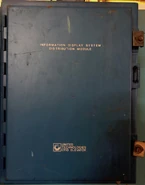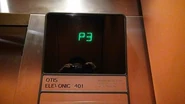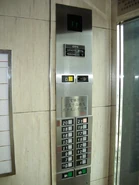The Otis Elevonic 401 was a traction elevator system introduced by Otis in 1981. This model was discontinued in 1992 and was succeeded by Otis Elevonic 411, although it continued to be sold for a few years more in Asia and possibly selected countries. The name "Elevonic" is a portmanteau between the words "Elevator Control" and Computer Electronic". Otis Elevonic 401 was developed with cooperation between United Technology and Hamilton Test System at UT's Hartford Research Center.
Overview
Otis Elevonic 401 was the first elevator control system with synthesized speech as an option, information display, and security systems. It was also one of the first elevator systems equipped with weight sensors so that fully loaded cars could bypass hall calls for safety reason. Elevonic 401 dispatched cars in response to variants in building traffic as they occurred. The Otis Elevonic 401 was later succeeded by the Otis Elevonic 411 and Elevonic 411M in 1990. Not all Otis Elevonic 401 elevators say Elevonic 401 on the panel. These usually have a speed of 1000-1200 fpm.
The Elevonic 401 synthesized speech uses a form of computerized speech synthesis and has 111-word vocabulary (supplied by Memco)[1]. It can greet passengers, say whether the elevator is going up or down, announce floors and safety messages.
Some notable features included in this model are:
- Solid State Direct Drive which works as a motor drive that replaces motor generator (MG) sets. It could save energy to around 20-40% compared to a standard Ward Leonard MG set.
- Transducers as sensitive recorders that rapidly sends information to the data processing center to adjust the operational system of each elevators. There are at least four solid state transducers that works as supporting system by changing signals in electric waves and sends them over to the controllers, they are:
- Primary Position Transducer (PPT) which replaces mechanical selector.
- Secondary Position Transducer (SPT) which monitors leveling accuracy of each elevators and measures the car position to within 8 mm.
- Primary Velocity Transducer (PVT) which adjusts the elevator speed.
- Load Weighing Transducer (LWT) which informs the car weight or load accuracy.
- Multiplexing which transmits multiple signals simultaneously over a single wire. It reduces the need of three traveling cables with about 80 wires to just one cable with only 50 wires.
Specifications
Although exact specifications are unknown, these are the options known to exist.
- DC Gearless Machine with Motor-Generator set (older) or Silicon Controlled Rectifier Drive (newer)
- 350/500/700|350/500/700/800/1000/1200/1400+ FPM speeds (imperial).
- Speed up to 6m/s (metric).
- Center open or slide open doors
- Can have a rear door.
- Can serve up to 73 floors.
- Maximum 8 car per group.
- Can be in a double deck configuration.
- Otis Series 1 (older/newer), Otis Lexan (older/newer) or Otis Vanity fixtures.
- 3500/4000/4500/5000 lbs. capacities (and 3000 lbs. capacity per cab for double deck, imperial)
- Up to 2500 KG capacities (1500 KG for double decker, metric)
Notable installations
- Main article: List of notable Otis Elevonic 401 elevator installations
Gallery
Videos
[1] - 43 Bridge street Hurstville
Audio
| Description | Audio |
|---|---|
| The sound played when the Otis Series 1 Grandpa Voice "Going up!" is used. | |
| The sound played when the Otis Series 1 Grandpa Voice "Going down!" is used. | |
| The sound played when the Otis Series 1 Grandpa Voice nudge mode announcement is used. | |
| The sound played when the Otis Series 1 Grandma Voice "Going up!" is used. | |
| The sound played when the Otis Series 1 Grandma Voice "Going down!" is used. | |
| The sound played when the Otis Series 1 Grandma Voice nudge mode announcement is used. | |
| The floor passing beep. (Note: The floor number on the indicator pre-changes, and the floor passing beep's pitch can be customized.) |
Trivia
- The Otis Elevonic 401's synthesized speech voices can be changed to voices like the "Series 1 Grandpa and Grandma" voices.
- The floor passing chime sounds the second floor it passes. It has a delay for the first floor it passes when it is moving. In addition, the floor passing chime pitch can be customized.
- Elevonic 401 is probably the first high-rise elevator system to use a floor skipping text, in this case, "EZ" which is an abbreviation for "Express Zone". The same feature was later adopted by its successor, Elevonic 411.
Notes and references
See also
- Competitors
External links
- ELEVONIC 401, Sentuhan canggih dari Otis (Indonesian) - an article about Otis Elevonic 401
















